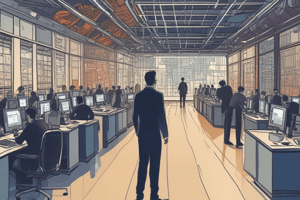Podcast
Questions and Answers
Which organizational level is primarily supported by operational-level systems?
Which organizational level is primarily supported by operational-level systems?
- Senior Management
- Operational Managers (correct)
- Middle Management
- Strategic Decision Makers
What is the primary focus of strategic-level systems in an organization?
What is the primary focus of strategic-level systems in an organization?
- Addressing long-term strategic issues (correct)
- Controlling production processes
- Managing employee data
- Monitoring daily transactions
Which type of information system is used to keep track of elementary activities and transactions?
Which type of information system is used to keep track of elementary activities and transactions?
- Decision-Support Systems (DSS)
- Transaction Processing Systems (TPS) (correct)
- Executive Support Systems (ESS)
- Management Information Systems (MIS)
What is the main purpose of Management Information Systems (MIS)?
What is the main purpose of Management Information Systems (MIS)?
Executive Support Systems (ESS) are primarily used for what purpose?
Executive Support Systems (ESS) are primarily used for what purpose?
In which functional area would you typically find systems focused on sales region analysis and inventory control?
In which functional area would you typically find systems focused on sales region analysis and inventory control?
Which type of system is primarily involved in activities like annual budgeting and profitability analysis?
Which type of system is primarily involved in activities like annual budgeting and profitability analysis?
What kind of information system supports long-term forecasting and personnel planning?
What kind of information system supports long-term forecasting and personnel planning?
Which functional area is most closely associated with transaction processing systems (TPS) for payroll and employee recordkeeping?
Which functional area is most closely associated with transaction processing systems (TPS) for payroll and employee recordkeeping?
What is the role of Human Resource Information Systems (HRIS) in an organization?
What is the role of Human Resource Information Systems (HRIS) in an organization?
Which of the following is a core function offered by a Human Resource Information System (HRIS)?
Which of the following is a core function offered by a Human Resource Information System (HRIS)?
How do companies utilize the internet in the context of Human Resource Information Systems (HRIS)?
How do companies utilize the internet in the context of Human Resource Information Systems (HRIS)?
What is the primary purpose of an Accounting Information System (AIS)?
What is the primary purpose of an Accounting Information System (AIS)?
Which of the following is a basic function of an Accounting Information System (AIS)?
Which of the following is a basic function of an Accounting Information System (AIS)?
Which of the following applications is typically integrated within an Accounting Information System (AIS)?
Which of the following applications is typically integrated within an Accounting Information System (AIS)?
What is the key function of a Financial Information System (FIS)?
What is the key function of a Financial Information System (FIS)?
Capital budgeting, investment management, and financial planning are activities typically managed under which system?
Capital budgeting, investment management, and financial planning are activities typically managed under which system?
What component of a Financial Information System (FIS) focuses on maximizing profits from investments?
What component of a Financial Information System (FIS) focuses on maximizing profits from investments?
Which component of a Financial Information System (FIS) records revenue and expenditure to facilitate organizational maintenance?
Which component of a Financial Information System (FIS) records revenue and expenditure to facilitate organizational maintenance?
What is the primary goal of a Marketing Information System?
What is the primary goal of a Marketing Information System?
How does a Marketing Information System (MKIS) assist in understanding consumer behavior?
How does a Marketing Information System (MKIS) assist in understanding consumer behavior?
Which of the following is a key function of a Marketing Information System?
Which of the following is a key function of a Marketing Information System?
What is the role of a Manufacturing Information System in a company?
What is the role of a Manufacturing Information System in a company?
Which function does a Manufacturing Information System provide to assist engineers in product design?
Which function does a Manufacturing Information System provide to assist engineers in product design?
How do Manufacturing Information Systems contribute to production processes?
How do Manufacturing Information Systems contribute to production processes?
In what way does a Manufacturing Information System aid in raw materials management?
In what way does a Manufacturing Information System aid in raw materials management?
What does 'E-Business' refer to?
What does 'E-Business' refer to?
Which of the following is an example of E-Business?
Which of the following is an example of E-Business?
What is the main purpose of a cross-functional enterprise system?
What is the main purpose of a cross-functional enterprise system?
Which of the following is a goal achieved by using cross-functional systems?
Which of the following is a goal achieved by using cross-functional systems?
What exemplifies a cross-functional information system?
What exemplifies a cross-functional information system?
What is the purpose of Enterprise Resource Planning (ERP) systems?
What is the purpose of Enterprise Resource Planning (ERP) systems?
Which business process is typically integrated in an ERP system?
Which business process is typically integrated in an ERP system?
Which benefit is typically associated with Enterprise Resource Planning (ERP) systems?
Which benefit is typically associated with Enterprise Resource Planning (ERP) systems?
In commerce, what does the term 'supply chain' refer to?
In commerce, what does the term 'supply chain' refer to?
What does Supply Chain Management (SCM) oversee?
What does Supply Chain Management (SCM) oversee?
According to the image, which component is the first step in the supply chain management?
According to the image, which component is the first step in the supply chain management?
What benefit is associated with effective Supply Chain Management?
What benefit is associated with effective Supply Chain Management?
What primary function does a Customer Relationship Management (CRM) system serve?
What primary function does a Customer Relationship Management (CRM) system serve?
How does a Customer Relationship Management (CRM) system benefit businesses?
How does a Customer Relationship Management (CRM) system benefit businesses?
Flashcards
Operational-level systems
Operational-level systems
Supports operational managers by tracking elementary activities and transactions.
Management-level systems
Management-level systems
Serve the monitoring, controlling, decision-making, and administrative activities.
Strategic-level systems
Strategic-level systems
Help senior management tackle and address strategic issues.
Human Resource Information System (HRIS)
Human Resource Information System (HRIS)
Signup and view all the flashcards
Accounting Information System (AIS)
Accounting Information System (AIS)
Signup and view all the flashcards
Financial Information System (FIS)
Financial Information System (FIS)
Signup and view all the flashcards
Marketing Information System
Marketing Information System
Signup and view all the flashcards
Manufacturing Information Systems
Manufacturing Information Systems
Signup and view all the flashcards
E-Business
E-Business
Signup and view all the flashcards
Cross-functional enterprise system
Cross-functional enterprise system
Signup and view all the flashcards
Customer Relationship Management (CRM)
Customer Relationship Management (CRM)
Signup and view all the flashcards
Enterprise Resource Planning (ERP)
Enterprise Resource Planning (ERP)
Signup and view all the flashcards
Supply Chain Management (SCM)
Supply Chain Management (SCM)
Signup and view all the flashcards
Study Notes
Types of Business Information Systems
- Organizations consist of different levels, including operational, management, and strategic levels.
- The functional areas of businesses are sales and marketing, manufacturing and production, finance and accounting, and human resources.
- Groups served by these systems range from operational managers to middle managers and senior managers.
Major Types of Systems in Organizations
- The main categories of information systems serve different organizational levels.
- Operational-level systems support operational managers in tracking elementary activities and transactions.
- Management-level systems serve the monitoring, controlling, decision-making, and administrative activities.
- Strategic-level systems help senior management tackle and address strategic issues.
- Major types of systems are Transaction Processing Systems (TPS), Management Information Systems (MIS), Decision-Support Systems (DSS), and Executive Support Systems (ESS).
- Functional areas include sales and marketing, manufacturing and production, finance and accounting, and human resources.
Information Systems Covered
- Human Resource Information System
- Accounting Information System
- Financial Management Information System
- Marketing Information System
- Manufacturing Information System
- E-Business System, specifically Cross-Functional Enterprise System
Human Resource Information System
- Human Resource Management (HRM) involves control of employees working in a firm.
- HRM includes recruitment, placement, annual performance evaluation, and compensation/career development.
- HRIS is needed to perform all these functions.
- HRIS is a software or online solution for data entry, tracking, and management of human resources operations.
- HRIS offers functions such as Time & Attendance, Training, Performance Management, Recruitment & Selection, and Compensation & Benefits Management.
- The internet allows companies to do recruitment.
- Intranets give companies access to employee information, which allows the collection of updated details around-the-clock.
- Employees can download company policies, staff benefits, training details, and their own performance data.
Accounting Information System (AIS)
- AIS is a system that collects, stores, and processes financial and accounting data to produce informational reports for decision-making.
- The basic functions of AIS are to collect and store data about business activities efficiently, to supply information for decisions including managerial reports and statements, and ensure controls are in place to record and process data accurately.
- Applications in AIS include order processing, inventory control, accounts receivable/payable, payroll, and general ledger.
Financial Information System (FIS)
- FIS is a computer-based system that gathers, stores, and analyzes financial information for decision-making.
- FIS can assist business professionals and top management make critical decisions about the organization's future financial state.
- Various activities under financial management include capital budgeting, investment management, cash management, and financial planning.
- FIS analyzes finance-related activities to take optimum decisions, which helps in achieving organizational goals.
- Components of FIS:
- Financial Accounting: Records financial transactions, assets, liabilities, revenue, and expenditure, which is useful for maintaining statements.
- Fund Management: The main aim is to maximize profits from investment.
- Controlling: Records revenue and expenditure of departments, and leads desirable change by controlling activities for organizational maintenance.
Marketing Information System
- A system where marketing data is formally gathered, stored, analyzed, and distributed to managers to make marketing decisions.
- It provides effective tools that help users make decisions about consumer behavior and the marketing mix, including how products are placed, priced, and promoted.
- Functions include planning, promotion, sales of existing products, developing new products based on customers' needs/market trends, better understanding customers, recognizing market trends/changes, and analyzing competition.
Manufacturing Information System
- A computer-based system working with other functional systems to support management in solving manufacturing-related problems.
- Functions include:
- Designing: Helps engineers design better products.
- Production: Facilitates better/automated production processes.
- Raw Materials: Helps plan the types of material needed in the production process.
- Production scheduling, shop floor operation: Integrates manufacturing requirement planning.
- Performance monitoring: Monitors performance and factory floor operations.
E-Business System
- E-Business means using the Internet, networks, and IT to support E-Commerce, Enterprise communications/collaboration, and Web-enabled business processes.
- Cross-Functional Enterprise System is an example.
Cross-Functional Enterprise System
- Cross-functional information systems involve software applications designed to support collaboration, coordination, and information exchange between multiple departments in an organization.
- Automate and streamline work processes, increase operational efficiency, and improve decision-making.
- Examples include:
- Customer Relationship Management (CRM)
- Enterprise Resource Planning (ERP)
- Supply Chain Management (SCM)
- The common goal of these systems is to provide all departments with a single source of data to make informed decisions with the same information.
Customer Relationship Management
- CRM is used by businesses to manage interactions with their current and potential customers.
- CRM is a form of software with internet capabilities that help a company to manage customer relationships in a well-organized manner.
- CRM provides tools for businesses and employees to deliver fast, appropriate, steadfast and reliable service to customers.
ERP System
- ERP integrates functions such as planning, purchasing, inventory, sales, marketing, finance, and human resources into one system.
- ERP benefits include data security, increased productivity, centralized data, visibility, compliance, scalability, mobility, cost savings, customer service, reporting, forecasting, and flexibility.
Supply Chain
- A supply chain is a system of organizations, people, activities, information, and resources involved in supplying a product or service to consumers.
Supply Chain Management (SCM)
- SCM is a system to oversee the flow of goods and services, also including all processes that transform raw materials into final products.
- Effective management of a smart supply chain can lead to better collaboration, higher efficiency, reduced overhead costs, improved risk mitigation, improved cash flow, the ability to keep up with demand, improved quality control, and shipping optimization.
Studying That Suits You
Use AI to generate personalized quizzes and flashcards to suit your learning preferences.




